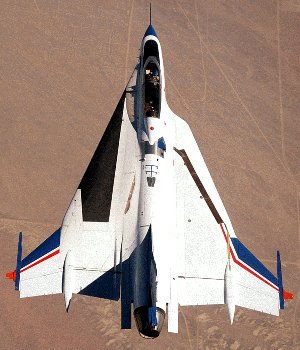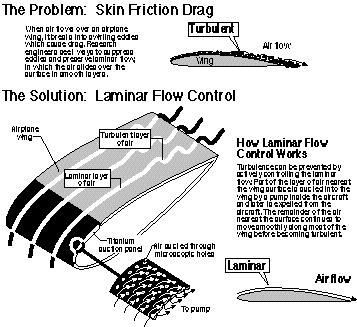 |
|||||
| Home | Research | For Teachers | HISTORY Level 1 Level 2 Level 3 |
PRINCIPLES Level 1 Level 2 Level 3 |
CAREER Level 1 Level 2 Level 3 |
| Gallery | Hot Links | What's New! | |||
| Web Administration and Tools | |||||
 |
|||||
| Home | Research | For Teachers | HISTORY Level 1 Level 2 Level 3 |
PRINCIPLES Level 1 Level 2 Level 3 |
CAREER Level 1 Level 2 Level 3 |
| Gallery | Hot Links | What's New! | |||
| Web Administration and Tools | |||||
![]()
One goal of NASA's High-Speed Research (HSR) program is to achieve laminar, or smooth, airflow over the surface of an aircraft's wing while flying at supersonic speeds. A supersonic (faster than the speed of sound) transport flying through the atmosphere at twice the speed of sound is extremely sensitive to aerodynamic drag generated by air friction on its surface.
By maintaining laminar, or smooth, non-turbulent flow at the surface of the wing, thereby reducing drag, it is possible to increase an aircraft's fuel efficiency .
To test this concept, NASA is using an experimental wing surface attached to the NASA F-16XL at the NASA Dryden Flight Research Center in Edwards, Calif.

F-16XL with supersonic laminar flow control experiment (black area on
left wing, front) or Ůglove.Ó
The F-16's large delta wing is similar to the design that likely will be used on the future High-Speed Civil Transport (HSCT), making the F-16XL an excellent testbed for the laminar flow research project.
The large, experimental glove has been attached to the upper surface of the F-16XL's left wing to keep the airflow from becoming turbulent. The glove has been fitted with a titanium suction panel. A suction system below the panel and within the fuselage draws part of the air flowing over the wing through 10 million tiny laser-cut holes in the glove.

As an aircraft flies through the atmosphere, a portion of its total aerodynamic drag is caused by the friction of stationary air meeting the surface of the moving aircraft. The F-16XL laminar flow test panel is designed to create a laminar, or smooth, layer of air at the leading edge of the wing, and produce flow characteristics which will help maintain that laminar flow.
The suction system attached to the glove is designed to stabilize the air flowing over the wing, and prevent it from becoming turbulent.
The experimental glove, which has already produced some laminar flow in flight tests, is designed to verify that the entire concept is effective for large, supersonic transports, such as the future U.S. HSCT.
Researchers also expect data from the F-16XL flight experiments to validate computer codes that will aid in the design of future supersonic airliners with laminar flow characteristics.
The following information was extracted from NASA Langley Research
Center.
For more information contact:
Office of Public Affairs
Mail Stop 115
NASA Langley Research Center
Hampton, VA 23681-0001
(757) 864-6124
Send all comments to ![]() aeromaster@eng.fiu.edu
aeromaster@eng.fiu.edu
© 1995-98 ALLSTAR Network. All rights reserved worldwide.
Updated: February 23, 1999